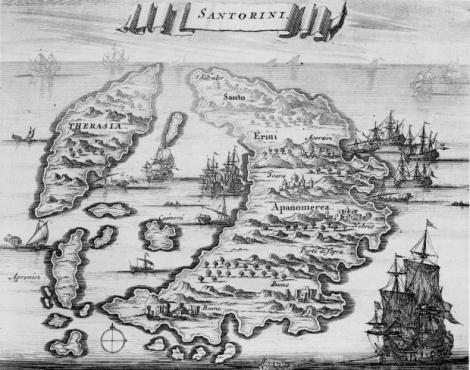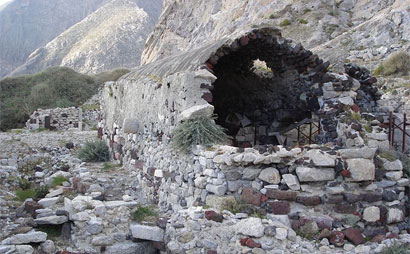Santorini / The Island
Naming Santorini Through the Ages

ANCIENT MAP OF SANTORINI
A Brief History : From Strongili to Santorini
- Few islands in Greece are mentioned as often in ancient literature and myths as Santorini. And during the course of time even fewer have repeatedly changed not only shape but name.
- Through the ages, Santorini has been known as Strongili 'The Round One', which was the first name, Kalliste 'the Fair One', Filitera or Filotera, Kalavria, Karisti, Tevsia, Thirameni and Rineia. When the Turks occupied Greece (1579-1821) during the time of the Ottoman Empire, they called the island 'Gozi', 'Dermetzik' or 'Dimertzik' (the latter means small mill, so it is likely that name came from the small windmills on the island).
- After the liberation of Greece in 1821, the name 'Thira' was established as the official name of the island. In spite of this, maps abroad had the island marked as 'Santa Irina'. Until today Greeks still refer to the island as Santorini.
How Santorini was named Strongili : 'The Round One'
- The first Volcanic craters began to form about 2,000,000 years ago southwest of where Profitis Ilias is today. Over time the craters broke through the sea and then united to form what is now Akrotiri.
- Later volcanic activity would create other craters to the north of the already existing island. The volcanic cones, and the rocky islet pre-dating them, slowly began to unite, due the volcanic matter spilling out during the eruptions. Eventually one island was formed. Herodotus tells us that the island’s first name came from that formation – 'Strongili' or 'The Round One', a name that dates back to 1500 BC.
- Buried under layers of ash and volcanic residue for centuries, the island shows no sign of colonization until around the middle of the 3rd millennium BC (Early Cycladic period). The settlers are said to have come from the Lelegian tribe, who set up colonies on other Cycladic islands.
- The Middle Cycladic Period followed, from approximately 2000/1900 BC to 1550 BC. Evidence has been discovered of settlers on both Santorini and Thirassia, communities of both farmers and seafaring folk.
- In the following years when Minoan Crete had become a maritime empire, Cretans came to settle on the island and intermarried with the locals. Evidence from the Akrotiri excavations show that this civilization was abruptly terminated at its peak, with the massive volcano eruption of 1550- 1500 BC. Somehow forewarned about the imminent disaster, probably with the earthquake which proceeded the eruption by one year, it seems that they left and did not return, since Akrotiri has yielded nothing of worth (i.e. jewelry, official seals, skeletons etc).
- All that remains of Strongili today is Santorini, Thirassia and Aspronisi.
How Santorini was named Kallisti or Kalliste
which means 'The Fair One'
- Mythology tells us that on their homeward journey, Euphemos, the son of the god Poseidon, received a clod of white soil as a gift from Triton. After leaving Anafi, he received a warning in the form of a clap of thunder and threw the soil into the sea. From this was formed the island of Kalliste, the most fair, which was later called Thera.
- Portrait : National Historical Museum, Athens
- But according to Herodotus, the Phoenicians were so enthralled by the beauty of Santorini that they settled there and gave it the name 'Kalliste' or 'The Fair One'.
How Santorini was named Thera :
- The name Thera comes from the commander Theras, son of Autesion of Sparta, who, as Herodotus of Alikarnassos (484-424 BC) tells us, had lead earlier colonists to Kalliste. "There were in the island now called Thera, but then Calliste, descendants of Menbliorus the son of Poeciles, a Phoenician; for Kadmus son of Agenor, in his search for Europa, had put in at the place now called Thera; and having put in, either because the land pleased him, or because for some other reason he desired to do so, he left in this island, among other Phoenicians, his own kinsman Membliarus. These dwelt in the island Kalliste for eight generations before Theras came from Lacedaemon". *
- Herodotus (IV .147)
- *Lacedaemon was the correct name for Sparta. The modern day name is Lakonia which is situated in the Peloponnese.
How the Island was named Santorini :
- For many years, it was thought that Santorini was given its name by the Venetians in the 13th century at the time of the Crusades and the fall of Constantinople in 1204. It is a reference to Saint Irene - 'Santa Irini' (from the Greek word 'ei - ri - ni ' = peace).
 THE BASILICA OF AGIA IRINI in PERISSA SANTORINIPhoto : Klearchos Kapoutsis
THE BASILICA OF AGIA IRINI in PERISSA SANTORINIPhoto : Klearchos Kapoutsis- The Venetians had a landing place at Riva on the island of Thirassia, where they erected a chapel in honour of Santa Irini (Saint Irene), who had become a martyr in Thessaloniki on the 23rd March in the year 303. Nowadays there is strong evidence that the Basilica of Agia Irini at the base of the mountain of Mesa Vouno gave Santorini its name, and not the chapel of Santa Irini in Thirassia.
